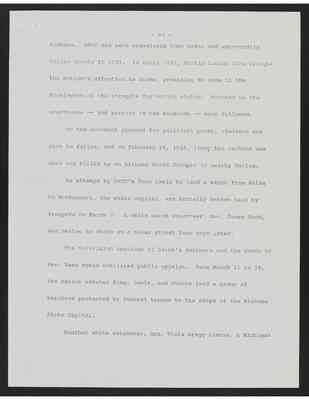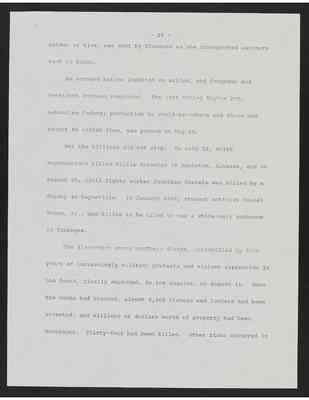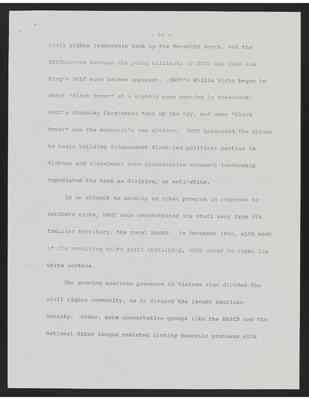Pages
26
Violence occurred in every other southern state as well. Lt. Colonel Lemuel Penn was shot to death in Colbert, Georgia, on July 11, 1964, nine days after President Lyndon B. Johnson signed the 1964 Civil Rights Act into law.
Despite the violence and brutality, the 1964 Freedom Summer was a success. The presence of white volunteers, most of them college students, turned the national spotlight on Mississippi, the most openy racist state. Political organizing began among Mississippi's Blacks, and the state's Black community began to conquer its fear of asserting its rights. Slowly, the federal government moved toward protecting civil rights workers.
The movement failed to unseat Mississippi's delegation to the 1964 Democratic Convention, or to prevent the seating of the state's congressional delegation in 1965. But it had made the United States confront the reality of southern racist terror as it never had before. A crack had appeared in the iceberg of the solid South.
The next stage for the movement's drama would be Selma,
27
Alabama. SNCC had sent organizers into Selma and surrounding Dallas County in 1963. In eary 1965, Martin Luther King brought the nation's attention to Selma, promising to make it the Birmingham of the struggle for voting rights. Marches on the courthouse -- and arrests in the hundreds -- soon followed.
As the movement pressed for political power, violence was sure to follow, and on February 26, 1965, Jimmy Lee Jackson was shot and killed by an Alabama State Trooper in nearby Marion.
An attempt by SNCC's John Lewis to lead a march from Selma to Montgomery, the state capital, was brutally beaten back by troopers on March 7. A white march volunteer, Rev. James Reeb, was beaten to death on a Selma street four days later.
The television beatings of Selma's marchers and the death of Rev. Reeb again mobilized public opinion. From March 21 to 25, the nation watched King, Lewis, and others lead a group of marchers protected by federal troops to the steps of the Alabama State Capitol.
Another white volunteer, Mrs. Viola Gregg Liuzzo, a Michigan
28
mother of five, was shot by Klansmen as she transported marchers back to Selma.
An enraged nation insisted on action, and Congress and President Johnson responded. The 1965 Voting Rights Act, extending federal protection to would-be -voters and those who sought to assist them, was passed on May 26.
But the killings did not stop. On July 16, white supremacists killed Willie Brewster in Anniston, Alabama, and on August 29, civil rights worker Jonathan Daniels was killed by a deputy in Hayneville. In January 1966, student activist Samuel Young, Jr., was killed as he tried to use a white-only bathroom in Tuskegee.
The discontent among northern Blacks, intensified by five years of increasingly militant protests and violent repression in the South, finally exploded, in Los Angeles, on August 11. When the smoke had cleared, almost 5,000 rioters and looters had been arrested, and millions of dollars worth of property had been destroyed. Thirty-four had been killed. Other riots occurred in
29
1965 in Chicago and Springfield, Massachusetts, and in more northern cities in 1966. By 1967, the nation shuddered under widespread racial riots. Detroit, Newark, and other cities exploded into flames.
By the end of the riotous summer of 1967, more than 17,000 people had been arrested, nearly 100 were dead, and over 4,000 were injured. Million of dollars in property was destroyed.
In the South, the legislative success of the Selma campaign created a slowdown in movement activity. The erupting violence in northern cities caught the southern civil rights leadership unprepared to transfer southern tactics used in winning voting rights to solving northern problems of poor housing, police brutality, poor education, and unemployment. The southern movement's nonviolence seemed useless in the cross-fire between snipers and police.
On June 6, 1966, James Meredith, the man who had entered the University of Mississippi after a bloody riot in 1962, was wounded on a one-man march against fear in Mississippi. The
30
civil rights leadership took up the Meredith march, but the differences between the young militants of SNCC and CORE and King's SCLC soon became apparent. SNCC's Willie Ricks began to chant "Black Power" at a nightly mass meeting in Greenwood. SNCC's Stokeley Carmichael took up the cry, and soon "Black Power" was the movement's new divider. SNCC harnessed the phrase to begin building independent Black-led political parties in Alabama and elsewhere; more conservative movement leadership repudiated the term as divisive, or anti-white.
In an attempt to develop an urban program in response to northern riots, SNCC soon concentrated its staff away from its familiar territory, the rural South. In December 1966, with most of its remaining white staff abstaining, SNCC voted to expel its white workers.
The growning American presence in Vietnam also divided the civil rights community, as it divided the larger American society. Older, more conservative groups like the NAACP and the National Urban League resisted linking domestic problems with




